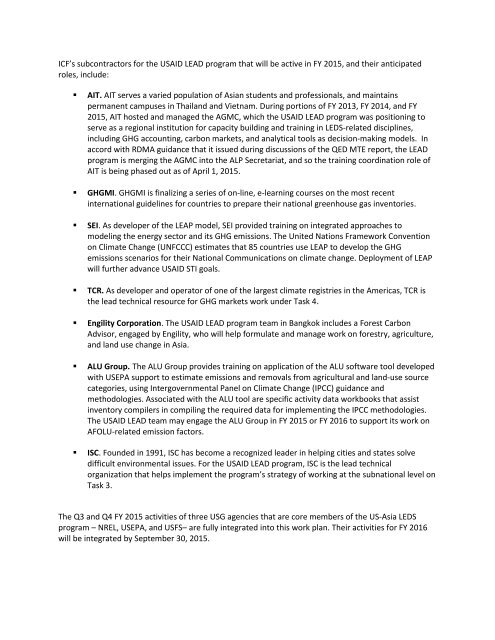ASIA LOW EMISSION DEVELOPMENT STRATEGIES (LEDS) WORK PLAN
PA00MMKZ
PA00MMKZ
Create successful ePaper yourself
Turn your PDF publications into a flip-book with our unique Google optimized e-Paper software.
ICF’s subcontractors for the USAID LEAD program that will be active in FY 2015, and their anticipated<br />
roles, include:<br />
• AIT. AIT serves a varied population of Asian students and professionals, and maintains<br />
permanent campuses in Thailand and Vietnam. During portions of FY 2013, FY 2014, and FY<br />
2015, AIT hosted and managed the AGMC, which the USAID LEAD program was positioning to<br />
serve as a regional institution for capacity building and training in <strong>LEDS</strong>-related disciplines,<br />
including GHG accounting, carbon markets, and analytical tools as decision-making models. In<br />
accord with RDMA guidance that it issued during discussions of the QED MTE report, the LEAD<br />
program is merging the AGMC into the ALP Secretariat, and so the training coordination role of<br />
AIT is being phased out as of April 1, 2015.<br />
• GHGMI. GHGMI is finalizing a series of on-line, e-learning courses on the most recent<br />
international guidelines for countries to prepare their national greenhouse gas inventories.<br />
• SEI. As developer of the LEAP model, SEI provided training on integrated approaches to<br />
modeling the energy sector and its GHG emissions. The United Nations Framework Convention<br />
on Climate Change (UNFCCC) estimates that 85 countries use LEAP to develop the GHG<br />
emissions scenarios for their National Communications on climate change. Deployment of LEAP<br />
will further advance USAID STI goals.<br />
• TCR. As developer and operator of one of the largest climate registries in the Americas, TCR is<br />
the lead technical resource for GHG markets work under Task 4.<br />
• Engility Corporation. The USAID LEAD program team in Bangkok includes a Forest Carbon<br />
Advisor, engaged by Engility, who will help formulate and manage work on forestry, agriculture,<br />
and land use change in Asia.<br />
• ALU Group. The ALU Group provides training on application of the ALU software tool developed<br />
with USEPA support to estimate emissions and removals from agricultural and land-use source<br />
categories, using Intergovernmental Panel on Climate Change (IPCC) guidance and<br />
methodologies. Associated with the ALU tool are specific activity data workbooks that assist<br />
inventory compilers in compiling the required data for implementing the IPCC methodologies.<br />
The USAID LEAD team may engage the ALU Group in FY 2015 or FY 2016 to support its work on<br />
AFOLU-related emission factors.<br />
• ISC. Founded in 1991, ISC has become a recognized leader in helping cities and states solve<br />
difficult environmental issues. For the USAID LEAD program, ISC is the lead technical<br />
organization that helps implement the program’s strategy of working at the subnational level on<br />
Task 3.<br />
The Q3 and Q4 FY 2015 activities of three USG agencies that are core members of the US-Asia <strong>LEDS</strong><br />
program – NREL, USEPA, and USFS– are fully integrated into this work plan. Their activities for FY 2016<br />
will be integrated by September 30, 2015.

















